The Festival of Britain was a national exhibition which opened in London and around Britain on 3 May 1951 and finished the end of September the same year.
At that time, shortly after the end of World War II, much of London was still in ruins and redevelopment was badly needed. The Festival was an attempt to give Britons a feeling of recovery and progress and to promote better-quality design in the rebuilding of British towns and cities following the war.
The principal exhibition site was on the South Bank Site, London of the River Thames. As part of the Festival in London, a new wing was built for the South Kensington Science Museum to hold the Exhibition of Science. Some 214,000 paying visitors went through the Exhibition of Science.
We know from Owen Holland's discussions with the late Mr W. J. `Bunny’ Warren, one of the talented BNI engineers recruited by Walter after the war, that six more tortoises of an improved electrical and mechanical design were built for Grey Walter in early 1951. [from Legacy…] .
[OBSERVATION: When looking at photographs of the various tortoises with their shells on, it is easy to determine which tortoises are from the later batch of 6 and which are the earlier Elmer or Elsie (or CORA even!) by the shell locating mounts. The later models run front and back and are more widely spaced, while the earlier models run from side to side and spaced more narrowly (see right-hand-side photo).]

The Festival of Britain catalogue shows an illustration of two tortoises, showing the earlier shells (and also the transparent antennae). This is probably because the material provided for the catalogue was prior to or during the Batch-of-6 construction.
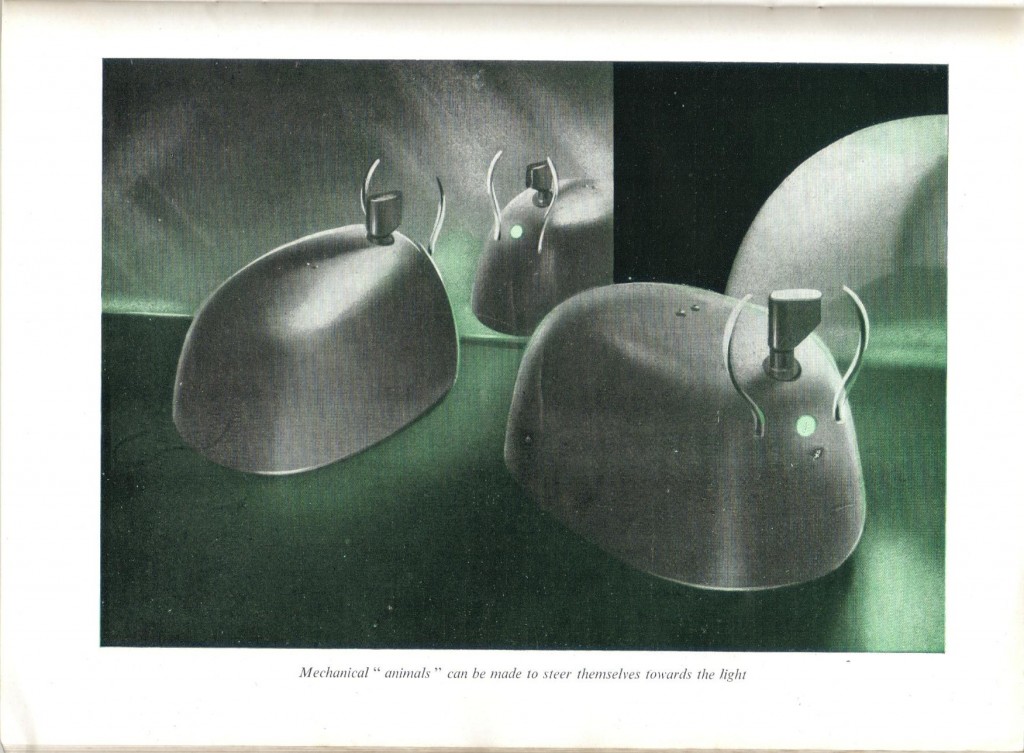
There were three tortoises on display at the Fob-EoS: Two of them were interacting in the pen, the third had a transparent shell and was used to advertise some of its internal components, namely [see page 50 of the catalogue]
- ES500 Radio valves, type DL93, for electronic "tortoises"; Mullard Electronic Products Ltd., Century House, Shaftsbury Avenue, London W.C.2.
- ES501 Exide accumulators, "Gel-cel" PRA 3S; Chloride Batteries Ltd., Exide Works, Clifton Junction, nr. Manchester.
- ES502 45-V batteries, "Batrymax" B109; The Ever Ready Company (Great Britain) Ltd., Hercules Place, Holloway, London N.7.
The tortoises themselves were an item in the catalogue-
- ES106 "Machina Speculatrix"; (Mechanical tortoises), Dr. Grey Walter, Burden Neurological Institute, Stapleton, Bristol.

Below is a photo from the Kew archives of the display pen (without the tortoises).
I've zoomed in and de-skewed the image (below). One can see the low-placed lamps inside the pen. The overhead photo is yet another image, slightly different to those already published, of the Buridan's ass dilemma being resolved by the tortoise's behaviour.
Here's an extract from Punch, June 6, 1951 p683 –
"Stop Press" deals with the realm of speculation, with the problem of life and death, the nature of the universe, the origin of cosmic rays, and so on; but, for anyone who feels unable to cope with such rarified theory, here are the two best toys in the exhibition. The first is the pen of electrical tortoises. Elmer and Elsie [note: not the originals], the creations of Dr. Grey Walter of Bristol, look rather like a couple of electric kettles crawling about the floor, the spout being replaced by a revolving periscope. Three lights are placed at floor level round the pen, which can be switched on (with a button, of course) by visitors; when a light is illuminated, the tortoise will creep towards it in a series of slow waltzing movements. Sometimes it will get temperamental and crawl off somewhere else; the public is warned that the tortoises' "behavoiur is complicated and sometimes unpredictable." Perhaps there was mutation in the family: this waltzing business can't be confined to mice.
[note: the second toy is the Ferranti "Nim" computer not discussed here.]
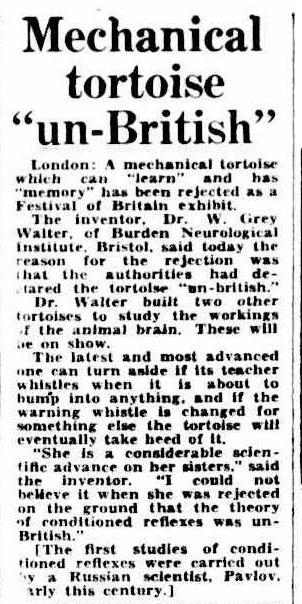
The inclusion of Grey Walter's Tortoises almost didn't happen…(Source: The Barrier Miner, [NSW, Australia}, 28 April 1951.)
Challenge: The British National Archives in Kew, London, also have a document about how the exhibition is to care for the tortoises. Due to bad advice only 2 days before I went out of my way to visit the Archives to view this document [June 2009] I was told that they were open. When I arrived, they were closed due to a public holiday on the following Monday. If someone who lives nearby was prepared to find this document and scan it / photograph it, and forward a copy onto me, it would be much appreciated. My contact email address is on the 'About' page. Here are the archive details: Dr.W.Grey Walter. Advice and supervision of Model of Electrical Tortoises. File No. G1/C 2/647 . Note that the Archive require advanced notice to pull the archive before you visit.
Here is the link to show the full details :
http://www.nationalarchives.gov.uk/catalogue/displaycataloguedetails.asp?CATLN=7&CATID=-1647089&j=1
**UPDATE** January 2015 – Steve Battle and his dad Ken contacted me :
"He [Ken] went through the entire sheaf of records most of which are unrelated to Grey Walter but turned up three documents. They refer to:
The 3 tortoises that were at the FoB were auctioned off at the end of the exhibition. Dr. Frederick Wesley "Wes" Clutterbuck and his wife Meryln were the successful bidders. The Clutterbuck's soon left England (1953), and spent some time in the West Indies before arriving in Australia. Originally stationed at Grafton in New South Wales, Dr. Clutterbuck contracted polio. He then moved to warmer conditions to Wynnum, near Brisbane in Queensland in 1966.
It is claimed that the two mobile tortoises (in dark shells) were destroyed in a fire in his surgery. The third tortoise, in the transparent shell, was later donated to the Smithsonian institute. Its chassis is stamped with the number 5 [Grey Walter’s is stamped number 6].
CHALLENGE: Wes and his wife passed away a few years ago (Wes -2004). I have been trying to track down the Clutterbuck's only daughter, Ms. Myvanwy Emery, persumably living in Grafton, NSW, if not then maybe living around Wynnum. I'm guessing she would be in her 60's by now. She had two sons, John and Christopher Emery. Between them we may be able to glean a bit more history about these tortoises.
Before the fire, the then Queensland Institute of Technology was loaned one of the tortoises. Here is the write-up and picture. Note that the Photo-electric cell is missing its shroud. Without this, performance and behaviour would have been erratic and disappointing to watch. The article says the unit was not operational at the time anyway.
I was successful in contacting Mr Paul Wilson [2008], but after the initial contact, his email address became invalid, and I have been unsuccessful in locating him since.
I managed to contact Myvanwy [nee] Clutterbuck in Aug 2012. She is the late Dr. Wes Clutterbuck's daughter and was 12 y/o when the tortoises were won at auction at FoB closure.
The Clutterbuck family is from Bristol. Myvanwy confirmed that two tortoises were destroyed in Wes' surgery fire.
The tortoises were nicknamed "Slo", "Mo" and "Shun" by Wes.
Myvanwy also confirmed The Smithsonian has the third remaining tortoise that he donated to them.
Dr. Wes Clutterbuck with his tortoises nicknamed "Slo", "Mo" and "Shun".
The charred remains of one of the tortoises after the surgery fire.
Here are some photos of the Smithsonian tortoise.
Note in the photo the Photo-Electric Cell (PEC) is missing from this photo. Also the steering is pointing backwards. The shroud is also missing.
Here's a crisper black and white photo
A photo found on flickr
Where are the others from the Batch of 6 now?
**update March 2015
Only two tortoises are known to exist:
- One in Science Museum London. #6 as used by WGW. Rediscovered by Owen Holland.
- One Tortoise in Smithsonian (ex Clutterbuck ex Festival of Britain) – Clear shelled version.
- Two tortoises destroyed in Clutterbuck's surgery fire. Ex FoB.
- One sent to Science Materials Center (US). Modified to use transistors. Not known to have been returned to WGW. Missing.
- One used for Eames IBM display. Not known to have been returned. – Missing.
Picture of the late 'Bunny' Warren (left) assisting in the construction of the replicas. Chris Hart next to him assisted Ian Horsfield (not pictured), both of Bristol Robotics Lab, in their construction.
See other Grey Walter and his Tortoises here.
See other Cybernetic Creatures here.

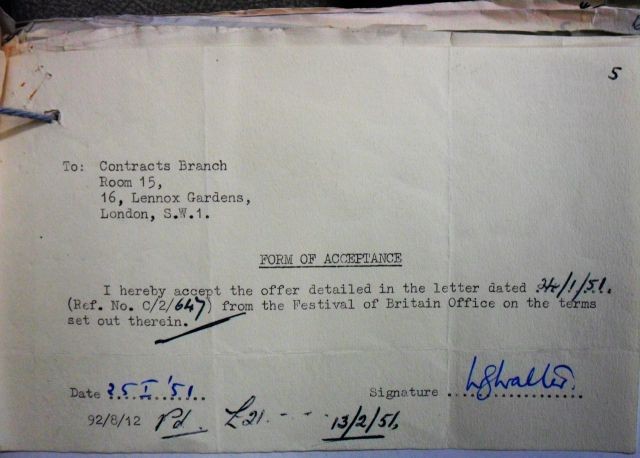
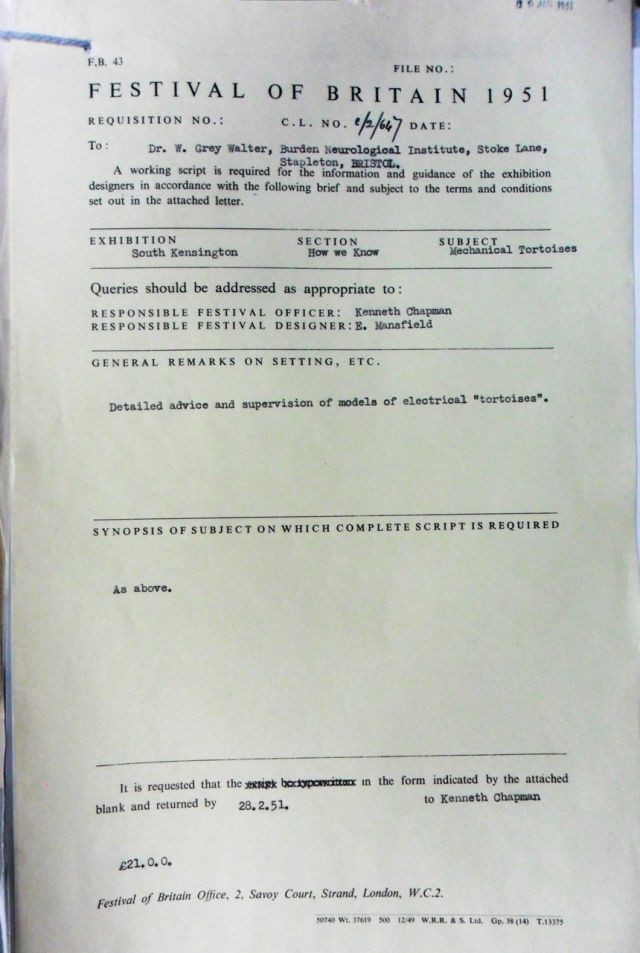
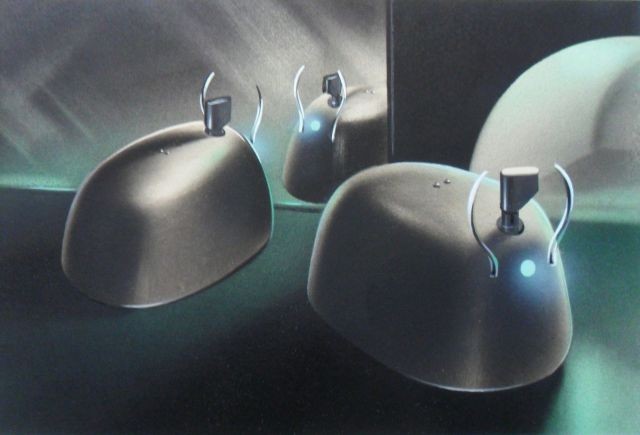

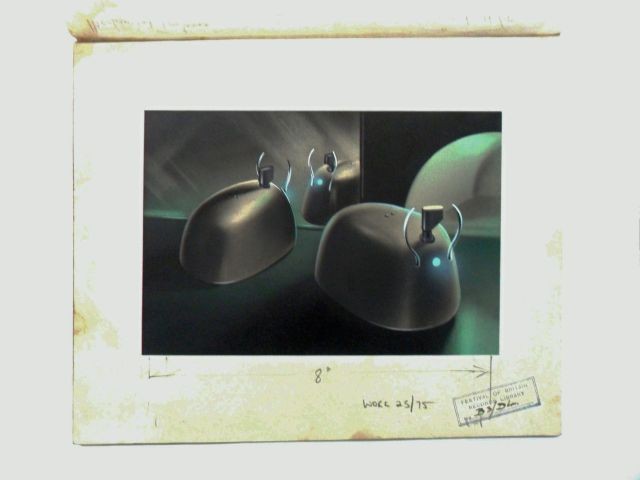
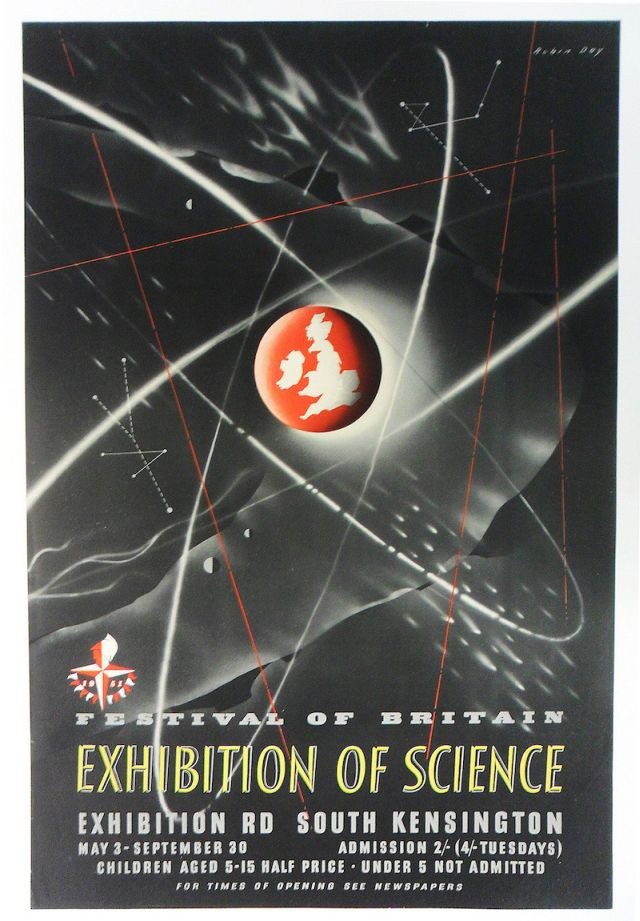
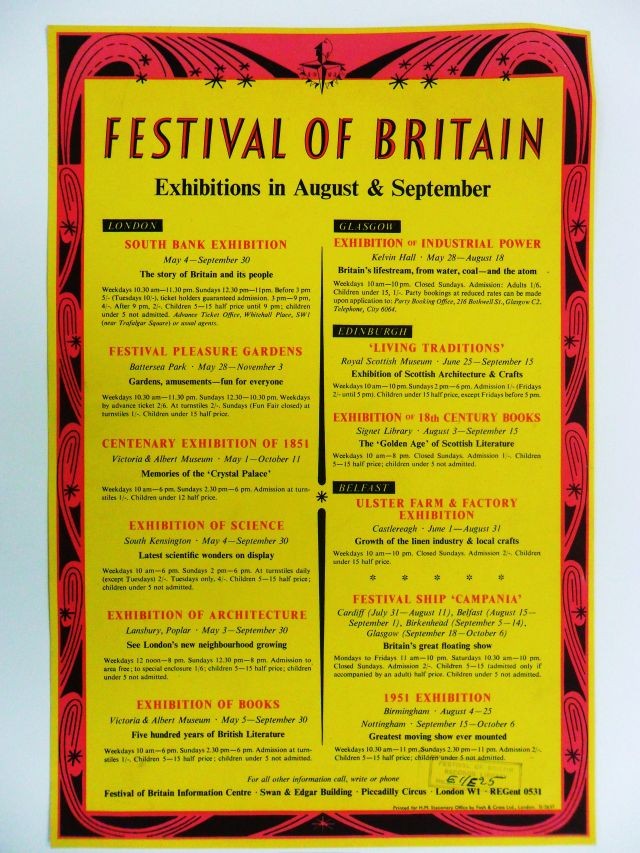
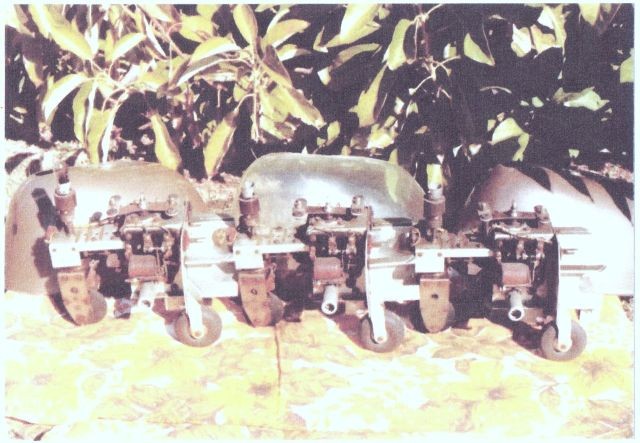

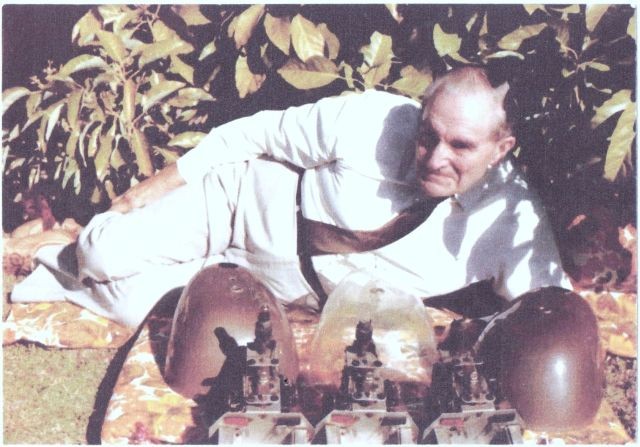
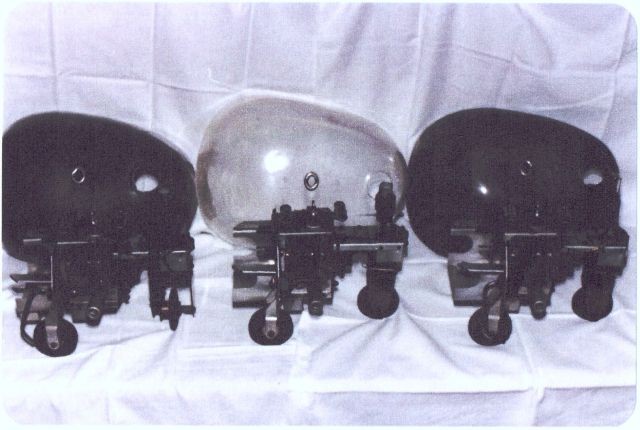


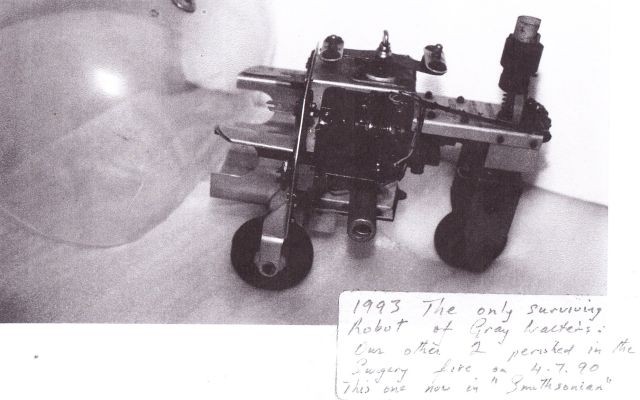

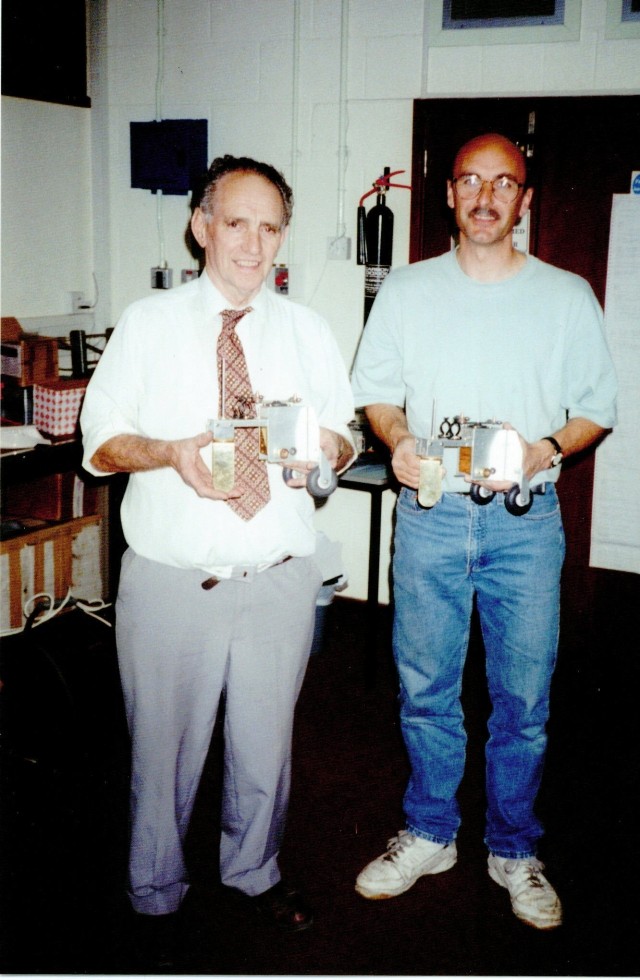
Hello,
Myvanwy is a friend of mine, I’ll take a copy of your request to her.
Susanne